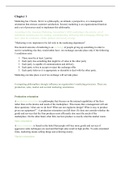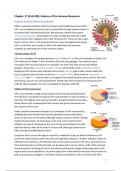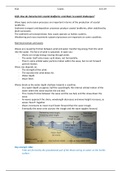Economics and management for business
Chapter 7 – Growth strategies
Organic growth is an increase in sales from the same or comparable retail space. In a market with
rapidly expanding demand, organic growth can be very sustainable. In mature markets, it can be slow
and limited to the rate of growth. Organic growth can be reduced by competition. Merging two similar
companies is referred to as horizontal growth, which occurs when a company develops or grows
activities at the same stage of the production process. Such growth brings in more sales, but it may
also enable a company to achieve economies of scale and bring down operating costs.
Diversification is the growth of the business in a related or unrelated market. Vertical chain of
production encapsulates the various stages of production from the extraction of a raw material input,
through the production of the product or service, to the final retailing of the product. Vertical
integration is integrating all stages of the production, to seek greater control over the value chain. We
accept the general proposition that firms are in business to maximize profits.
A firm might consider growth by acquisition, which involves one firm purchasing another firm. This
might occur by mutual consent or, in the case of a hostile takeover, the managers of the acquired firm
might try to resist the takeover, and a merger, which generally involves two companies agreeing by
mutual consent to merge their existing operations. In price-elastic markets there is a clear incentive for
firms to engage in a price war. If demand is price-inelastic it is better to raise prices in order to boost
total revenues. Mergers and acquisitions can lead to increased co-operation and the success of
cartels. Rationalization is associated with cutbacks in excess resources in the pursuit of increased
operational efficiencies. When two companies merge you can reduce cost by cutting back on one
finance department instead of two. The learning curve suggests that, as cumulative output increases,
average costs fall.
Industrial clusters occur when related industries co-locate in a region. Examples include Silicon
Valley and electronics, Germany and automotives, London and finance. If economies of scale are
important in a value-adding activity, it could be better for the manufacturer to abandon the raw material
division and buy from a larger independent company. Also buying raw material should be equal to the
marginal costs, but due to monopoly this almost never happens. Transaction costs are the costs
associated with organizing the transaction of goods or services. Under a complete contract all
aspects of the contractual arrangement are fully specified. However, no contract is ever complete. The
general factors that lead to greater transaction costs are: complexity (contract), uncertainty (contract),
monitoring (contractual arrangement), enforcement (contractual arrangement). If all this is present
then the transaction cost of operating through the market are low. The alternative is to organize the
transaction within the firm and use the hierarchy or managerial structure to organize the transaction.
Nexus of contracts is a collection of interrelated contractual relationships, where the firm represents
a nexus or central point, at which all these interrelated contractual relationships are managed in the
pursuit of profit. Another transactional problem is the hold-up problem, which is the renegotiation of
contracts, and is linked to assed specificity. A specific asset has a specific use; a general asset has
many uses. Firms will vertically go up or down the vertical chain if the transaction costs of operating
through the market are too high.
Economies of scope are said to exist if the cost of producing two or more outputs jointly is less than
the cost of producing the outputs separately (cost firm A + cost firm B > cost firm A+B). Diversification
can reduce a company’s exposure to risk. Diversified portfolio of activities contains a mix of
uncorrelated business operations. If two business activities are correlated, then the profit levels of
each activity will move together.
Chapter 7 – Growth strategies
Organic growth is an increase in sales from the same or comparable retail space. In a market with
rapidly expanding demand, organic growth can be very sustainable. In mature markets, it can be slow
and limited to the rate of growth. Organic growth can be reduced by competition. Merging two similar
companies is referred to as horizontal growth, which occurs when a company develops or grows
activities at the same stage of the production process. Such growth brings in more sales, but it may
also enable a company to achieve economies of scale and bring down operating costs.
Diversification is the growth of the business in a related or unrelated market. Vertical chain of
production encapsulates the various stages of production from the extraction of a raw material input,
through the production of the product or service, to the final retailing of the product. Vertical
integration is integrating all stages of the production, to seek greater control over the value chain. We
accept the general proposition that firms are in business to maximize profits.
A firm might consider growth by acquisition, which involves one firm purchasing another firm. This
might occur by mutual consent or, in the case of a hostile takeover, the managers of the acquired firm
might try to resist the takeover, and a merger, which generally involves two companies agreeing by
mutual consent to merge their existing operations. In price-elastic markets there is a clear incentive for
firms to engage in a price war. If demand is price-inelastic it is better to raise prices in order to boost
total revenues. Mergers and acquisitions can lead to increased co-operation and the success of
cartels. Rationalization is associated with cutbacks in excess resources in the pursuit of increased
operational efficiencies. When two companies merge you can reduce cost by cutting back on one
finance department instead of two. The learning curve suggests that, as cumulative output increases,
average costs fall.
Industrial clusters occur when related industries co-locate in a region. Examples include Silicon
Valley and electronics, Germany and automotives, London and finance. If economies of scale are
important in a value-adding activity, it could be better for the manufacturer to abandon the raw material
division and buy from a larger independent company. Also buying raw material should be equal to the
marginal costs, but due to monopoly this almost never happens. Transaction costs are the costs
associated with organizing the transaction of goods or services. Under a complete contract all
aspects of the contractual arrangement are fully specified. However, no contract is ever complete. The
general factors that lead to greater transaction costs are: complexity (contract), uncertainty (contract),
monitoring (contractual arrangement), enforcement (contractual arrangement). If all this is present
then the transaction cost of operating through the market are low. The alternative is to organize the
transaction within the firm and use the hierarchy or managerial structure to organize the transaction.
Nexus of contracts is a collection of interrelated contractual relationships, where the firm represents
a nexus or central point, at which all these interrelated contractual relationships are managed in the
pursuit of profit. Another transactional problem is the hold-up problem, which is the renegotiation of
contracts, and is linked to assed specificity. A specific asset has a specific use; a general asset has
many uses. Firms will vertically go up or down the vertical chain if the transaction costs of operating
through the market are too high.
Economies of scope are said to exist if the cost of producing two or more outputs jointly is less than
the cost of producing the outputs separately (cost firm A + cost firm B > cost firm A+B). Diversification
can reduce a company’s exposure to risk. Diversified portfolio of activities contains a mix of
uncorrelated business operations. If two business activities are correlated, then the profit levels of
each activity will move together.









